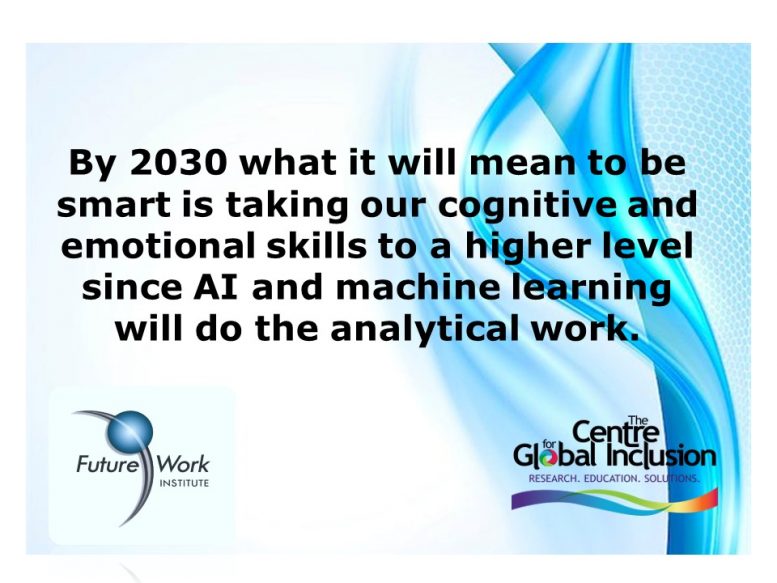To end the week, we are moving from AI and Bias to the other side of the coin: AI for Good. Altruistic applications of AI are emerging in multiple sectors including education, health, law and the environment. AI’s main advantage over humans is its ability to detect incredibly subtle patterns within large quantities of data and to learn from them. For cognitive tasks, this ability to learn means that computers are no longer limited to simply carrying out a rote set of instructions written by humans. Instead, they can continuously learn from new data and perform better than their human programmers.
So, what it will mean for humans to be “smart” in 2030 is taking our cognitive and emotional skills to a higher level, including greater empathy. AI and Machine Learning will do the analytical work and will be better at perseverance, compliance and diligence. Humans will be better at curiosity, creativity, passion, humor and empathy.
AI for Good is a United Nations platform, centered around annual Global Summits. It fosters the dialogue on the beneficial use of Artificial Intelligence, by developing concrete projects. The AI for Good series aims to bring forward Artificial Intelligence research topics that contribute towards more global problems, in particular through the Sustainable Development Goals. To further promote Artificial Intelligence and Machine Learning research that advance the achieving of the Sustainable Development Goals, an AI Repository was created, which includes AI for Good projects and examples. https://www.itu.int/en/ITU-T/AI/Pages/ai-repository.aspx
Learn more about ten key areas where AI for good is developing here: https://www.nesta.org.uk/blog/ai-good-it-real/
See Microsoft examples of AI for Good in education, environmental advocacy, accessibility, and healthcare here: https://www.microsoft.com/en-us/ai/ai-for-good
According to a June 2017 study by the consulting firm PwC, AI’s advance will generate $15.7 trillion in additional wealth for the world by 2030. Here are some examples of AI for Good that will enhance our life in 2030 and beyond:
- Knewton, an adaptive learning platform offering free and open source tools leverages machine learning to personalize content to each user to improve academic outcomes.
- Quill provides free online grammar tools targeted at low-income students. The company’s mission is to help 30 million low-income K-12 students become stronger writers.
- To better predict air pollution levels and improve air quality, IBM established Green Horizons. The system has been implemented in China and combines AI and IoT to churn out predictive analytics based on data collected from connected sensors installed throughout Beijing. The initiative aims to achieve a 25 percent reduction in particulate matter.
- To address nationwide food safety concerns, a team at the Sustainability and Artificial Intelligence Lab at Stanford University has instituted an AI program that uses machine learning to predict crop yield. The project uses existing and publicly transmitted remote sensing data to estimate the amounts of crops that will be produced several months prior to the harvest season. The goal is to provide planters with information that will allow them to make more thorough planting and food reservation decisions.
- To make mental health services more accessible, X2AI’s Tess is a chatbot that doesn’t require an app and is accessible through multiple platforms to provide personalized psychotherapy support. Tess can hold conversations with patients, offer mental health education and provide health-related reminders.
- Woebot is a chatbot accessible through the Facebook Messenger developed based on research by scientists at Stanford University. Results from the study showed that Woebot led to reduced instances of “anxiety and depression among people aged 18-28 years old.”
- London-based company xRapid created an automated Malaria diagnosis tool using a blood smear that is reported to deliver results in 30 seconds with 98 percent accuracy. The app, delivered through the iPhone, is designed to provide results faster and more inexpensively than standard tests on the market.
- The Brain Power Autism System (BPAS) uses AI to equip autistic children and adults with the ability to “teach themselves practical life skills” and to track their progress numerically.
- NGO charity: water created a chatbot that simulates conversations with a fictional Ethiopian girl named “Yeshi” as a way to raise awareness about access to clean water.
- Ecoisme is a smart home application and energy monitoring system which is connected to your mobile phone. It detects all major home appliances, measures power consumption and analyses the user behavior. By sending out reminders and suggestions for positive behavior, it promises to save up to 15% of electricity consumption.
This is what AI for Good is about. In order to do so, we have to
- Create efficient incentives for innovators to develop AI applications for sustainable use
- Ensure the responsible application of all AI technology, everywhere
- Promote AI education, literacy and accessibility in order to prevent a threatening digital divide
- Strengthen global exchange and cooperation around the topic to make sure that the right ideas and solutions find their suitable targets.


